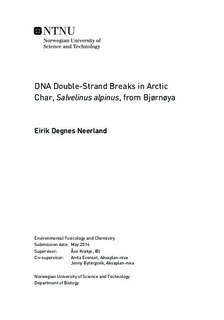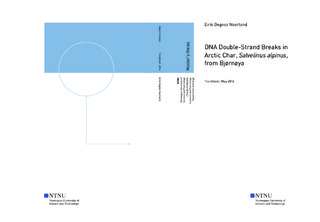| dc.description.abstract | Long-range atmospheric transport has led to persistent organic pollutants (POPs) finding their way far from their sources of origin and into the Arctic and are accumulated in biota. The activity of large seabird colonies has caused high levels of biomagnified POPs to be deposited into Lake Ellasjøen of Bjørnøya (74.30° N, 19.01° E). The salmonid fish, Arctic char (Salvelinus alpinus), is the only fish species on the island and is also found in Lake Ellasjøen. The aim of the present study was to investigate the potential genotoxic effect of environmental exposure to organochlorines (OCs) in Arctic char from Ellasjøen, as compared to Arctic char from the relative pristine Lake Laksvatn.
A total of 39 individuals, 18 from Ellasjøen and 21 from Laksvatn, were used in the study. Blood of char was analysed by using agarose gel electrophoresis and image data analysis to quantify the DNA-fraction, of total DNA, that migrated into the gel (DNA-FTM) and the median molecular length of the DNA fragments that left the well during gel electrophoresis (MML) as relative measures of DNA double-strand breaks (DSBs). Muscle samples were analysed by GC-MS to quantify the content of organochlorines (OCs) in the fish. Statistical analysis was used to see if there were any associations between DNA-damage, OCs, and biological variables.
Between-lake comparisons showed a 43 times higher concentration of ∑OCs in Arctic char of Ellasjøen compared with Laksvatn char. There was also a significant difference between fish of the lakes regarding DNA DSBs. Char of Lake Ellasjøen had a much higher level of DSBs, as measured by both DNA-FTM and MML, than Lake Laksvatn. The difference in DNA DSBs was significantly correlated with the levels of OCs in the fish. Several other differences were found between the fish of the lakes: Ellasjøen char had smaller relative liver weights and a lower body growth rate.
Further studies should investigate whether this increased level of DNA damage in the Ellasjøen population could impair the health of the fish and by extension the health of the population. The high and low exposure scenario of the two lakes could also provide for powerful studies of evolutionary toxicology of the char stock of Bjørnøya. | |

